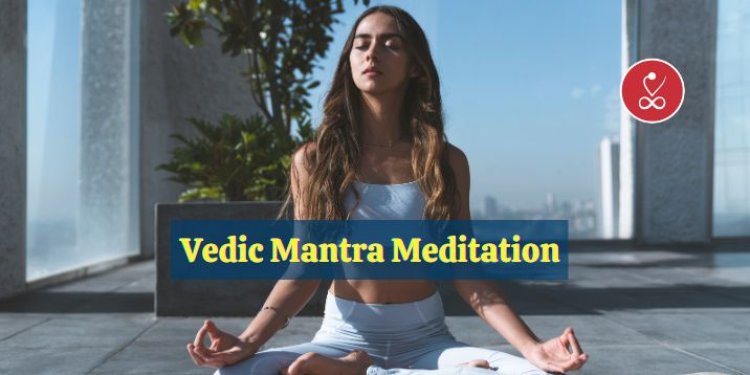What to Do If You Can’t Focus During Vedic Mantra Meditation
Engaging in Vedic mantra meditation can occasionally prove to be demanding, particularly when staying focused is difficult.
Share this Post to earn Money ( Upto ₹100 per 1000 Views )

Engaging in Vedic mantra meditation can occasionally prove to be demanding, particularly when staying focused is difficult. Disruptions and meandering thoughts are typical, but there are effective strategies to navigate these hurdles and enrich your experience.

What to Do When You Struggle to Focus During Vedic Mantra Meditation
Embrace Wandering Thoughts: Rather than fighting against stray thoughts, gently recognize them and redirect your attention to the mantra. With time, you’ll find that these thoughts will decrease in frequency and intensity.
Reduce Your Meditation Duration: If you’re just starting out or having trouble concentrating, consider shorter sessions. Begin with 5 minutes and gradually extend them as your focus improves.
Utilise Mala Beads: Employing a mala (a rosary of 108 beads) allows you to concentrate on the tactile sensation of sliding each bead through your fingers, helping to ground your mind and diminish distractions.
Practise Deep Breaths: Prior to commencing your mantra, take a few deep breaths to unwind. Deep breathing soothes the nervous system and primes the mind for concentration.
Chant Aloud or in a Whisper: If meditating silently isn’t aiding your focus, try chanting out loud or softly whispering the mantra. The sound serves as an anchor for your mind, often improving concentration.
Envision the Mantra’s Meaning: Illustrate the meaning or essence tied to the mantra, such as light or tranquillity, enveloping you. This visualisation enriches the practice and can bolster focus.
Establish a Daily Meditation Schedule: A habitual practice can facilitate concentration. When you meditate at the same time every day, your mind becomes conditioned to relax, easing the journey to focus over time.
Cultivate Patience: Meditation is a skill that blossoms with time and patience. Some days will feel easier than others, so practise self-compassion and persevere.
Conclusion:
Vedic mantra meditation is a profound practice that offers inner tranquillity, mental clarity, and a strong connection to universal energy. While sustaining focus can be demanding, straightforward methods like using mala beads, shortening your sessions, or visualising the mantra’s essence can enhance concentration. With consistent practice and patience, your mind will gradually learn to settle, revealing the profound power of Vedic mantra meditation.
FAQs
Qus1: Is it normal to lose focus often during meditation?
Ans: Yes, it is typical to lose focus, especially for beginners. When you catch your mind wandering, simply redirect your attention back to the mantra. Over time, keeping your focus will become less challenging.
Qus2: Can I meditate using any mantra?
Ans: Although you can choose any mantra, it is advised to begin with simple, universal mantras like “Om” or “Om Namah Shivaya.” A teacher or mentor can assist in selecting a mantra suited to your individual aspirations.
Qus3: What if I feel drowsy during meditation?
Ans: If drowsiness arises, try sitting upright rather than lying down. Meditating with your eyes slightly ajar or voicing the mantra can help retain alertness.
Qus4: How many times should I say the mantra in each session?
Ans: There isn’t a fixed number, but traditionally, it’s 108 repetitions (using mala beads). However, prioritise quality over quantity — repeat the mantra as many times as feels comfortable and natural.
Qus5: Can Vedic mantra meditation alleviate stress and anxiety?
Ans: Absolutely, the rhythmic repetition of a mantra can soothe the mind and alleviate stress. It has also been shown to reduce blood pressure and ease tension.
Qus6: What is the distinction between silent and loud chanting?
Ans: Silent chanting is internal, fostering a deeper focus and concentration. Loud chanting employs vocal energy, which can assist in anchoring your attention and is often beneficial for beginners or those having difficulty focusing.
Qus7: Is understanding the mantra’s meaning necessary?
Ans: While beneficial, it is not essential. Mantras operate through sound vibrations, and their advantages can be experienced even without fully grasping their meaning.
Qus8: May I meditate with music playing in the background?
Ans: Soft, instrumental music without lyrics can create a calming ambiance, but it’s best to avoid music that draws your attention away from the mantra. Aim for a serene atmosphere whenever possible.
Qus9: How long does it take to observe the benefits of Vedic mantra meditation?
Ans: Some benefits, like decreased stress, can be felt right away, while others, such as improved focus, develop gradually with regular practice over weeks or months.
Qus10: Should I adopt a specific posture for Vedic mantra meditation?
Ans: Sitting with a straight back is advisable, but comfort is paramount. You can sit cross-legged on the floor, in a chair, or on a cushion — whatever you find most soothing and conducive to sustained focus.















